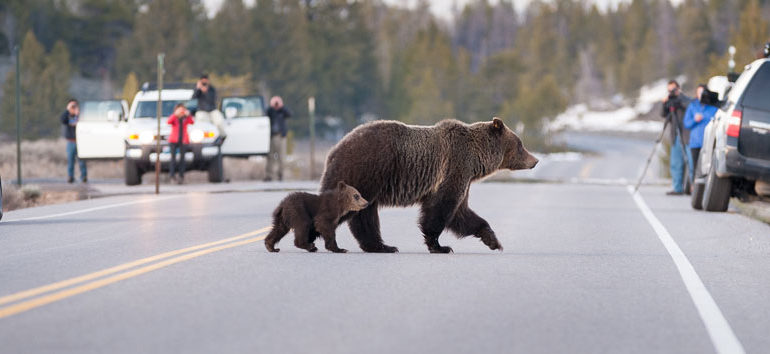by Wyoming Wildlife Advocates | MARCH 3, 2016
The US Fish and Wildlife Service today proposed to remove Yellowstone grizzly bears from the protections of the Endangered Species Act.
Wyoming Wildlife Advocates believes removing these protections is premature.
Due to the increasing effects of climate change and loss of critical food sources, as well as increased human pressure throughout the ecosystem, these bears remain vulnerable.
Since listed as a threatened species in 1975, the world of the Yellowstone grizzly has significantly changed.
Threats to grizzlies will actually increase after delisting, especially from the powerful anti-predator special interests, both corporate and user groups, that have long lobbied for delisting. These special interests will use their influence to create anti-predator legislation and regulation and will seek to exploit habitat critical to sustaining grizzly recovery.
Climate change forecasts generated by Yellowstone National Park’s own scientists are ominous and the long term effects on the ecosystem and grizzlies are unclear but will likely lead to significant disruption of food and habitat resources.
Already, two of the grizzly’s four highest quality food sources have nearly vanished. Because of well-documented warming trends, pine beetles have infested and killed most whitebark pine trees, which produce nutritious nuts for grizzlies. Native cutthroat trout are nearly gone from Yellowstone Lake, because illegally-introduced, non-native lake trout have preyed on and nearly decimated the cutthroat.
Grizzlies have dispersed farther to the periphery of their ranges in search of meat to replace the lost pine nuts and trout. This has led to increased conflicts, primarily with livestock and hunters, and death. For 2015, a record number of known grizzly deaths, 59, were reported.
We see little evidence that the states intend to make conflict prevention a priority.
After delisting, Montana, Wyoming and Idaho have pledged to allow the bears to be hunted for sport. This will only add to the annual number of deaths.
In fact, one of the greatest threats grizzlies face comes from state game and fish agencies which have an inherent conflict of interest between managing game species and sustaining a recovered species that preys on valued game species. The two missions are in direct opposition to each other.
Wyoming aggressively hunted grey wolves to minimal numbers when they were delisted. We see little evidence that any of the three states will exercise restraint when they initiate grizzly hunts. We are concerned that, without robust oversight from the federal government, the states will once again place the bears in jeopardy.
Hunting of bears also forecloses the possibility of connectivity to other grizzly populations, leaving the GYE population genetically isolated. Connectivity, long a goal of conservationists and grizzly managers alike, is quite simply being abandoned.
Another important unaddressed issue is funding for post delisting management.
With oil and gas prices in the cellar, Wyoming – where the majority of bears live – is facing a major budget crisis. Delisting puts the responsibility for funding post-delisting grizzly management squarely on the states. It remains to be seen whether the states will ante up.
With the population essentially flat since 2007 and mortalities increasing, we believe it is prudent to wait a few more years to determine whether the population is secure, sustainable and resilient enough withstand future challenges.
You can find the delisting rule and other information at this link.

